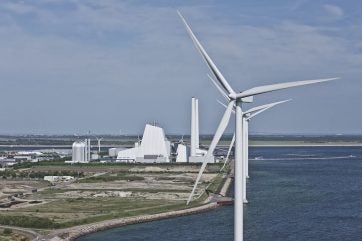
In a landmark deal, Ørsted is to sell a further one million tonnes of carbon removal over a ten-year period to Microsoft from Avedøre power station, which is part of the bioenergy with carbon capture and storage (BECCS) project ‘Ørsted Kalundborg CO2 Hub’. This new agreement builds on an existing commitment by Microsoft to buy 2.67 million tonnes from Asnæs power station, bringing the total purchase under contract to 3.67 million tonnes of CO2.
As part of the ‘Ørsted Kalundborg CO2 Hub’, Ørsted will establish carbon capture at its wood chip-fired Asnæs power station in Kalundborg, western Zealand, and at the Avedøre power station’s straw-fired boiler in the Greater Copenhagen area. 430 000 tonnes per year of biogenic CO2 from the combined heat and power plants will be shipped to a storage reservoir in the Norwegian part of the North Sea and sequestered permanently. The ‘Ørsted Kalundborg CO2 Hub’ is set to become operational by the beginning of 2026.
The new agreement between Ørsted and Microsoft entails Microsoft taking one million tonnes of carbon removal from the straw-fired unit at Avedøre Power Station starting from 2026. The combined heat and power plant converts locally sourced straw, which is a by-product of agriculture, into electricity and district heating. By capturing the biogenic carbon dioxide from biomass-fired power plants and storing it underground, it is possible to achieve negative emissions, ie removal of CO2 from the atmosphere.
The collaboration between Ørsted and Microsoft will play a vital role in developing the ‘Ørsted Kalundborg CO2 Hub’, as bioenergy-based carbon capture and storage is still in its early stages. Even though the project was awarded a subsidy from the Danish Energy Agency, the revenue from the sale of carbon removal certificates was taken into account in the investment decision and in the offer submitted via the Danish subsidy scheme, which put great emphasis on competitive offers with the lowest amount of subsidy per tonne.
According to the latest report from the UN’s Intergovernmental Panel on Climate Change (IPCC), carbon removal technologies such as BECCS are crucial for limiting global warming. This underscores the importance of projects such as the ‘Ørsted Kalundborg CO2 Hub’, which can support companies like Microsoft in achieving their sustainability goals and contribute to achieving global climate targets.
Ole Thomsen, Senior Vice President and Head of Ørsted’s Bioenergy business, says: “This expanded collaboration with Microsoft is a testament to our shared vision for a sustainable future. By combining Ørsted’s expertise in bioenergy carbon capture and storage with Microsoft’s commitment to reducing its carbon footprint, we’re showcasing how strategic relations can accelerate the transition to a greener economy.”
For Microsoft, the agreement represents another large-scale carbon removal deal on the way towards the company’s aspiration to be carbon-negative in 2030.
Brian Marrs, Senior Director of Energy & Carbon Removals at Microsoft, says: “We’re proud once again to announce a landmark offtake agreement with Ørsted, which is pioneering responsible carbon removal development in Denmark while also meeting the needs of a decarbonised energy system. The urgency around climate goals means translating great planning into rapid action – and Ørsted remains a valuable collaborator in bringing big ideas to life. [This] announcement is yet another tangible step towards building the technologies and commercial capabilities towards becoming carbon-negative by 2030.”
B&W’s BECCS at Filer City, MI
Meanwhile, Babcock & Wilcox has been granted a limited notice to proceed (LNTP) by NorthStar Clean Energy to begin work on the BECCS conversion of a coal-fired power plant in Filer City, Michigan, using B&W’s biomass SolveBright™ post-combustion carbon dioxide capture technology.
B&W is working with NorthStar Clean Energy to finalise the full contract in alignment with an extensive front end engineering and design study conducted by B&W for the project. The LNTP allows B&W to begin detailed design and procurement work while the parties finalise the contract. Full notice to proceed is expected in the fourth quarter of 2024.
When the conversion project is complete, the Filer City power plant will use sustainable biomass as fuel – coupled with B&W’s SolveBright process – to generate power with net-negative greenhouse gas emissions. The plant will be capable of capturing up to 550 000 tons of CO2 annually, which will be permanently sequestered underground.
“As regulations require plant owners to significantly reduce or eliminate greenhouse gases from their coal-fired power generating assets, fuel-switching paired with CO2 capture can allow these assets to continue to provide economical and reliable baseload energy for many years to come,” said Jimmy Morgan, B&W EVP and COO.
The Filer City plant is jointly owned by Tondu Corp and NorthStar Clean Energy (a subsidiary of CMS Energy Corporation).
About the ‘Ørsted Kalundborg CO2 Hub’
- In May 2023, the Danish Energy Agency (DEA) awarded Ørsted a 20-year subsidy contract for its carbon capture and storage (CCS) project ‘Ørsted Kalundborg CO2 Hub.’
- Ørsted will capture 150 000 tonnes of biogenic CO2 per year from the straw-fired (formerly coal-fired) unit at Avedøre power station. The CO2 will initially be transported by lorry to Asnæs power station until an improved CO2 infrastructure can be established.
- The straw-fired unit at Avedøre converts locally sourced straw into electricity and district heating. The straw is a byproduct of agriculture.
- Ørsted will capture 280 000 tonnes of biogenic CO2 per year from the wood-chip-fired unit at Asnæs power station, which will also function as a CO2 hub, handling and shipping biogenic CO2 from both the Avedøre and Asnæs combined heat and power plants to the Northern Lights storage reservoir in the Norwegian part of the North Sea.
- The wood-chip-fired unit at Asnæs converts wood chips from primarily the Baltics into electricity, district heating, and process steam for local industry. The wood chips come from sustainably managed production forests and “consist of residues from trimming or from crooked trees,” says Ørsted.






